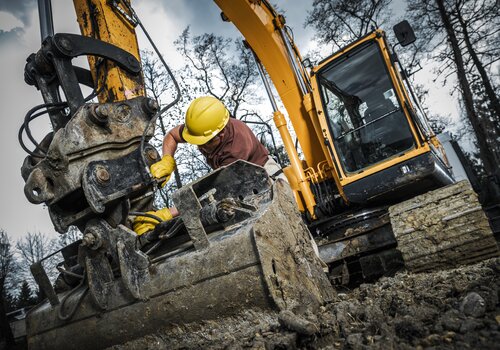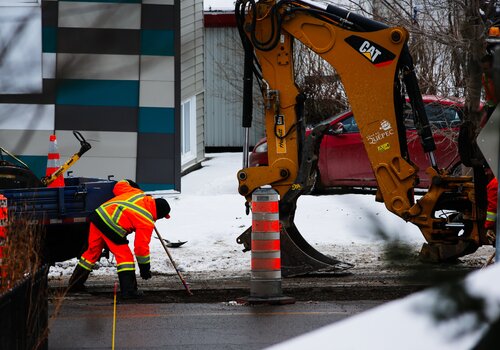If you’re thinking about investing in a new cone crusher you can expect a significant increase in productivity, even with less skilled operators. “With old-school cone crushers, it all came down to the experience of the operator,” said Wayne van Antwerpen, crusher technology product manager for Terex Materials Processing. “They can tell when the machine is not crushing effectively, even by the sound of the cone crushing. They read the dials, checked the product, and made necessary adjustments. Today automation does all that for the operator.” According to van Antwerpen, “Experienced operators will typically get the cone to crush at about 75 percent of peak performance, but when utilizing automation, the cone’s performance moves up to about 75-90 percent of peak.”
“Automation ensures the best possible performance,” said Vincent Celsi, vice president of crushers for Metso Outotec. In Metso’s MX cone crusher line, settings are automatically adjusted based on load conditions, which improves the utilization of wear parts as well as worker safety. Overloading of the crusher is prevented by controlling the setting, power and pressure.
Cone crushers typically work in a secondary, tertiary or quaternary crushing role, reducing the size and shape of rocks in the downstream of a crushing circuit. They reduce the material in a crushing cavity by continuous compression between a fixed element (bowl liner) and a moving element (mantle). An eccentric swinging movement produces a force strong enough to crush the rocks.
“The main advantage of cone crushers is the ability to process big tonnages at a very efficient operational cost,” said Vincent Celsi, vice president of crushers for Metso Outotec.
How to Select a Cone Crusher
When it comes to selecting the type of crusher, there aren’t any hard rules to follow. One consideration is how often you plan to move the crusher or use it in different applications. Floating bowl crushers, like the Terex TC cone, are easier to use because the liners don’t need to be changed every time you move it from a secondary to tertiary role. Screw bowl cone crushers require changing the concave and mantle liners to suit the specific application, but when configured correctly are excellent for high tonnage operations in mining or quarrying or recycling. Floating shaft (Spider Bearing) cone crushers have the ability to change the eccentric throw of the cone which gives it increased application versatility and productivity.
Metso’s MX series crushers first introduced in 2017, combine a fixed shaft with a rotating bowl. According to Celsi, operators do not have to stop the feed for setting changes and liner changes can be completed quickly. In addition to lower operational costs and improved energy efficiency MX crushers offer selective crushing capability.
“The MX crusher liners last 20-25 percent longer, depending on the application,” said Pierrick Boulay, product manager for Metso MX crushers.
Van Antwerpen cautions buyers to look at the bigger picture when deciding on which cone crusher to invest in. “You can get back your initial expenditure quickly but how much is it going to cost to you to run over the long term?” This requires calculating the cost of maintenance and replacement parts. “The biggest cost is always the wear parts and the crushers’ wear rates need to be considered on a cost/ton basis, but there are other factors too. For example, bronze bushing cones are more common than roller bearing cones, but on average roller bearings would last longer than bronze bushings in certain applications, sometimes up to three times longer,” said van Antwerpen. “But a set of roller bearings would be more expensive than a set of bronze bushings to replace.”
Celsi believes that it’s important for buyers to evaluate the ability of the manufacturer to deliver both service and parts. “I think buyers don’t just buy a machine, they look for trusted partners,” said Celsi.
New Cone Crushers at CONEXPO-CON/AGG 2020
- Advanced overload sensing technology to detect overload
- Increased speed ratio options to offer more flexibility in production
- Integrated user-friendly control system
- Dual-acting tramp release cylinders
- Maximum output: 518 tons per hour
- Maximum feed size: 240 mm
- Used for medium-hard to hard and abrasive natural rock; raw materials processing in mining applications
- Secondary and tertiary crushing
- Diesel-electric drive concept for lower fuel consumption; optional external power supply
- SPECTIVE control panel for easy operation, fault diagnosis
- Continuous feed system
(Johnson Crushers International)
- Head diameter: 48 inches
- Capacity: 506 tons per hour
- Reduce operating costs by up to 50%
- Roller bearing design
- Course and fine crushing applications
- Available in mobile and stationery units
- 510HP
- Maximum feed opening: 8.31 inches
- High speed, high throw 300HP cone
- User-friendly remote control with machine stop function
- Tracked
- Integrated hopper
- 90KW
- Maximum Feed size: 240mm, 200mm, 160mm
- Adjustable crushing chamber for medium, course and extra course materials
- Best for crushing river gravel, basalt and granite, along with abrasive materials in the mining industry
- Automation system maintains closed side settings in a stable position by tracking wear part abrasion; prevents damage if a non-crushable material enters the cavity
- Multi-action technology combines a rotating bowl and a piston
- Full automated piston and rotating bowl adjustments
- Dynamic setting adjustment and wear compensation can be done without stopping
- MX4 - 300HP; MX4 - 400HP
- Maximum feed size: MX3 - 9 ½ inches; MX4 - 10 1/8 inches
- Maximum throughput in metric tons per hour: MX3 - 300-420; MX4 - 400-600
- Up to 25% longer liner lifetime
- Metso Metrics Services for managing and monitoring equipment online
- High capacity mid-range cone crusher for secondary and tertiary crushing, designed for crushing applications in mines or large sized quarries
- Capacity 212 - 659 metric tons per hour
- Max feed size: 17 inches
- Automation and Connectivity System (ACS) continuously monitors and optimizes crusher performance
- 24/7 access to data via My Sandvik portal
- 500HP, 59 inches diameter
- Maximum feed opening 13.5 inches
- Patented tamp relief system
- Vantage automation for ease of operation
- 200HP
- Maximum feed opening 8 inches
- Throughput in metric tons per hour: 110-259
- Secondary and tertiary crushing
- Simple and safe hydraulic relief and clearing
- Anti-spin system prevents head spin to extend manganese life
- 422HP
- Spider-bearing cone with bronze bushings
- Secondary, Tertiary, Quaternary Crushing
- Maximum feed size 9.5 inches
- Automation hydraulically controls the cone’s CSS, even under load, and compensating for liner wear
- Automation controls optimum power requirement
- Logging of key operational parameters and performance indicators
- Advanced diagnostics
- Manufactures three types of cone crushers including floating bowl, screw bowl and floating shaft cone
- 1150 mm wide
- Secondary crushing
- Up to 264 tons per hour production rate
- Reduction ratio 6:1
Join more than 40,000 industry peers who receive construction industry news and trends each week. Subscribe to CONEXPO-CON/AGG 365.












